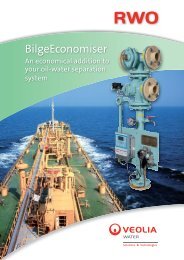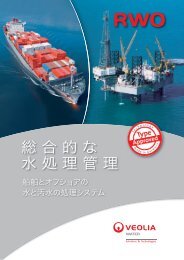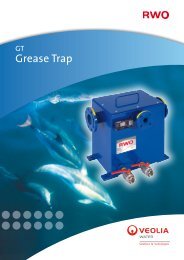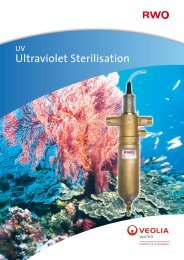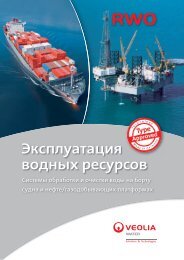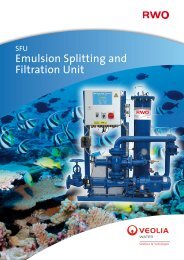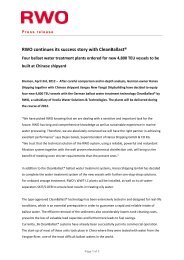the IHS Ballast Water Guide - RWO Marine Water Technology
the IHS Ballast Water Guide - RWO Marine Water Technology
the IHS Ballast Water Guide - RWO Marine Water Technology
Create successful ePaper yourself
Turn your PDF publications into a flip-book with our unique Google optimized e-Paper software.
Sponsored by <strong>IHS</strong> Fairplay Solutions <strong>Guide</strong> to <strong>Ballast</strong> <strong>Water</strong> Treatment Systems<br />
residual oxidants in <strong>the</strong> water coming from<br />
<strong>the</strong> ballast tanks are neutralised by sodium<br />
thiosulphate, which is injected from <strong>the</strong><br />
neutralisation module.<br />
The system is compact, can be designed as<br />
a skid-type version and straightforward to<br />
configure and install in a limited ed spa space. pa pace. pa pace ce.<br />
Ocean Protection<br />
Mahle<br />
2 3<br />
The Ocean Protection System (OPS) is a<br />
modular product that makes use of filtration<br />
and ultraviolet.<br />
The two-phase pre-treatment filtration<br />
system is described by <strong>the</strong> company as<br />
low maintenance and configurable for<br />
different flow volumes from 250m 3 /h up<br />
to 2,000m 3 /h. It can be operated ei<strong>the</strong>r as<br />
a compact, container-housed unit or can be<br />
adapted to suit <strong>the</strong> vessel’s design and layout<br />
making use of available space. The filtration<br />
stages have automatic self-cleaning.<br />
The first filtration phase uses <strong>the</strong> pressure<br />
differential of around 1.2bar induced in<br />
<strong>the</strong> ballast water stream by means of a disc<br />
attached to a pneumatic cylinder. This forces<br />
any coarse sediment and organisms to <strong>the</strong><br />
outer edges of <strong>the</strong> flow, where <strong>the</strong>y are<br />
removed by means of a flush valve.<br />
The cleaned water is <strong>the</strong>n redirected to<br />
<strong>the</strong> second stage of <strong>the</strong> filtration system . In<br />
this <strong>the</strong> smaller particles are removed using<br />
a 50µm filter element, which is regularly<br />
backflushed to keep it clean.<br />
The ballast water passes to a low-pressure<br />
UV radiation unit where <strong>the</strong> DNA of any<br />
remaining organisms is destroyed. The UV<br />
light is mostly in <strong>the</strong> 254-nanometre range.<br />
Treated ballast water passes back and forth<br />
between <strong>the</strong> ultraviolet radiation unit and<br />
<strong>the</strong> ballast tanks before being passed out of<br />
<strong>the</strong> OPS system.<br />
BAWAC<br />
Maritime Assembly Systems 3<br />
Germany-based Maritime Assembly Systems<br />
followed <strong>the</strong> G8 process with its BAWAC<br />
system. Land-based testing took place in a<br />
testing station in Singapore. The prototype<br />
500m3 /h BAWAC used seven fluid-cooled,<br />
metal steam UV lamps.<br />
A helix structure around <strong>the</strong> lamps ensures<br />
<strong>the</strong> water remains in <strong>the</strong> UV treatment area<br />
for longer than in straight-pass systems,<br />
distributes <strong>the</strong> light evenly. It also provides<br />
vibration damping for <strong>the</strong> quartz components.<br />
The seven burners are composed of<br />
three components. First, <strong>the</strong>re is <strong>the</strong> highperformance,<br />
long-life burner itself, which<br />
has low energy consumption. The burner is<br />
surrounded by quartz glass, which supplies<br />
it with cooling fluid. The rotating helix<br />
component distributes <strong>the</strong> light. It is driven<br />
by ballast water, providing indirect cooling of<br />
<strong>the</strong> burner and mechanical damping of <strong>the</strong><br />
quartz glass body. Wiper blades in <strong>the</strong> helix<br />
are pressed against <strong>the</strong> quartz glass cylinder<br />
hydraulically as water passes through th <strong>the</strong><br />
BAWAC, cleaning <strong>the</strong> system.<br />
MH Systems<br />
California-based MH Systems uses a<br />
combination of two treatment systems,<br />
deoxygenation and carbonation.<br />
An inert gas generator (IGG) is at <strong>the</strong> heart<br />
of <strong>the</strong> BWTS from MH Systems. The inert<br />
gas – which consists of 84% nitrogen, 12-<br />
14% CO 2 and around 2% oxygen – is bubbled<br />
through <strong>the</strong> ballast water by means of a row<br />
of diffusers with downward-pointing nozzles<br />
placed at <strong>the</strong> bottom of <strong>the</strong> tank.<br />
IGGs infuse <strong>the</strong> ballast water with inert<br />
gas bubbles until it attains a state of hypoxia,<br />
with a pH of nearly 5.5. The gas infusion<br />
© <strong>IHS</strong> Global Limited 2012 23<br />
012_037_CorrectedBW1204.indd 23 01/08/2012 15:33:45<br />
3



